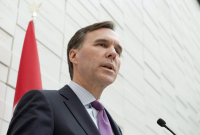Support strong Canadian climate journalism for 2025
The Trudeau government is introducing the second budget of its mandate today. Here are five things to look for:
1. Will the government provide a timeline to bring the country's books to balance?
The Liberals won the 2015 election on a platform that vowed to invest billions in measures like infrastructure and child benefits as a way to re-energize Canadian growth. They planned to run deficits to finance the investments, but promised annual shortfalls would not surpass $10 billion during the first couple years of their mandate. The Liberals also vowed to return to balance by 2019-20. Since taking office, however, the government abandoned those promises, citing a weaker-than-expected economy. Last fall, Finance Minister Bill Morneau's fiscal statement projected a string of double-digit deficits until at least 2021-22, starting with a $25.1-billion shortfall in 2016-17. Many economists have been urging the government to map out a timetable to eliminate the deficit. Morneau has instead focused on another so-called fiscal anchor, promising to lower the country's debt-to-GDP ratio — a measure of the public debt burden — by the end of the Liberal mandate.
2. If Canada's staying in deficit mode, how big will the shortfalls be?
Morneau has projected annual shortfalls across his outlook, but it remains to be seen how those predictions have evolved since his last update in November. Much has changed since then. The Canadian economy delivered a surprise in the final months of 2016 with growth that easily surpassed forecasts. The economic momentum has continued through the first months of 2017, with unexpectedly strong performances in key areas like trade, labour and housing. Economists have translated these promising indicators into more robust growth projections. Some experts are now predicting smaller deficits for the next couple of years; indeed, some believe the economy has improved so much since January that the forecast in Morneau's budget could be needlessly pessimistic, making it easier to beat those lower fiscal expectations down the road. Another key consideration is the potential impact of U.S. economic proposals, many of which could have major consequences for Canada. Those factors, however, have largely been left out of economic projections because the Trump agenda remains uncertain.
3. Will Ottawa re-introduce a contingency reserve?
Federal governments have long used accounting actions to set aside funds for emergencies. In recent years, the so-called contingency reserves have ranged from $1 billion to $6 billion per year. Last fall, the Liberal government removed the $6-billion annual risk adjustment that it introduced earlier in 2016 to cover unexpected problems. A government can also give the public a fresh look at its fiscal trajectory by tweaking the accounting buffers; Ottawa's deficit figures appeared slimmer last fall after it was eliminated. With so many unknowns tied to potential policy moves in the U.S. on taxes and trade, some economists predict the government will re-introduce a contingency reserve to provide a cushion for Canada's books.
4. What will be the scope of the feds' tax-expenditure review?
Morneau launched a comprehensive review of the tax system last June that enlisted seven experts to advise him on how he should proceed. During the election campaign, the Liberals vowed to undertake a broad review of existing tax expenditures as a way to find $3 billion per year in new revenue by 2019-20. The Liberals said their aim was to reduce tax benefits for the rich. But since the election of U.S. President Donald Trump, Ottawa is expected to proceed with caution. The Trump administration has indicated it wants to slash personal and corporate taxes in the U.S., which many fear would put Canada at a significant competitive disadvantage with its top trading partner. Experts have called on Ottawa to wait to see what Washington does before introducing major tax changes of its own in Canada. Sources say the review process is ongoing, meaning the budget will not include the full range of tax changes. However, the budget is expected to contain at least a few smaller tax adjustments.
5. How will the budget address gender gaps?
Morneau has promised to run his budget through a gender-based analysis and to publish the results. Such a tool would be expected to explore how a given budget measure might have different impacts on men and women as well as boys and girls. These studies also consider age, income, culture, ethnicity and other factors. This year's analysis is expected to examine how some of the big budget themes will affect genders. It's also expected to lay the foundation for a more in-depth process next year. Morneau's department plays a special role in gender-based analysis. Not only does it look at its own policies through this lens, it also reviews how other departments examine budget proposals before they are sent to Morneau's office.




Comments